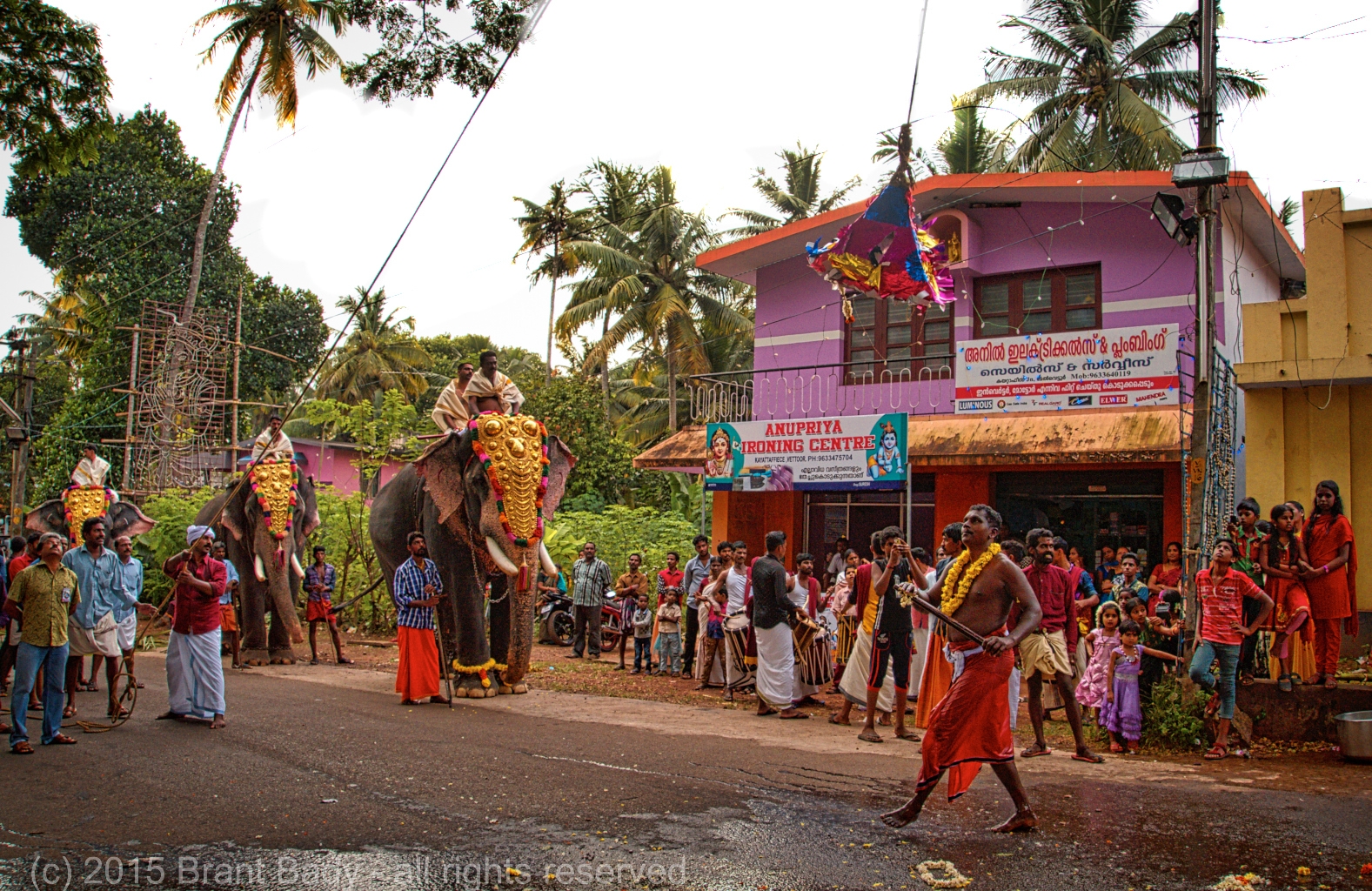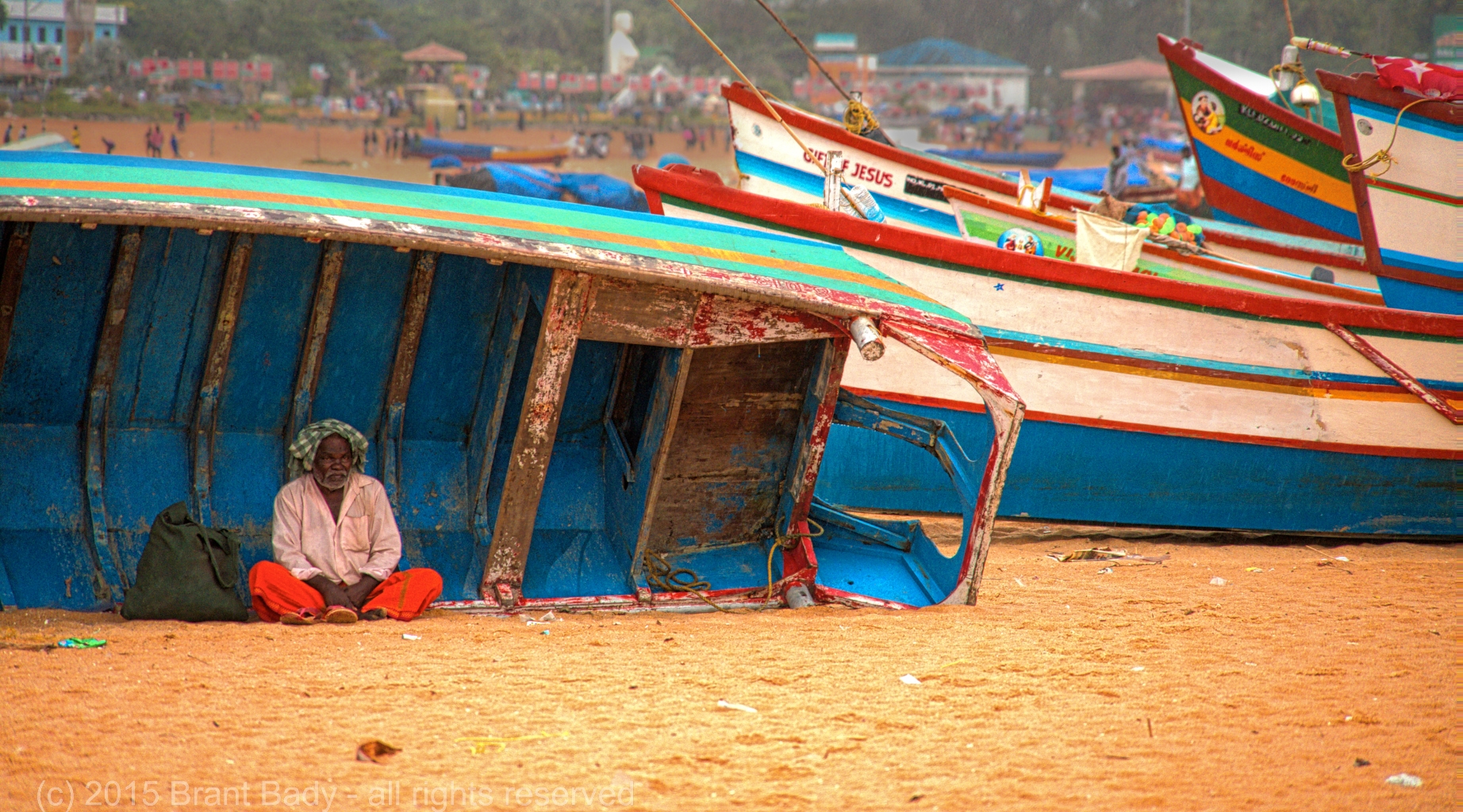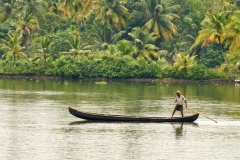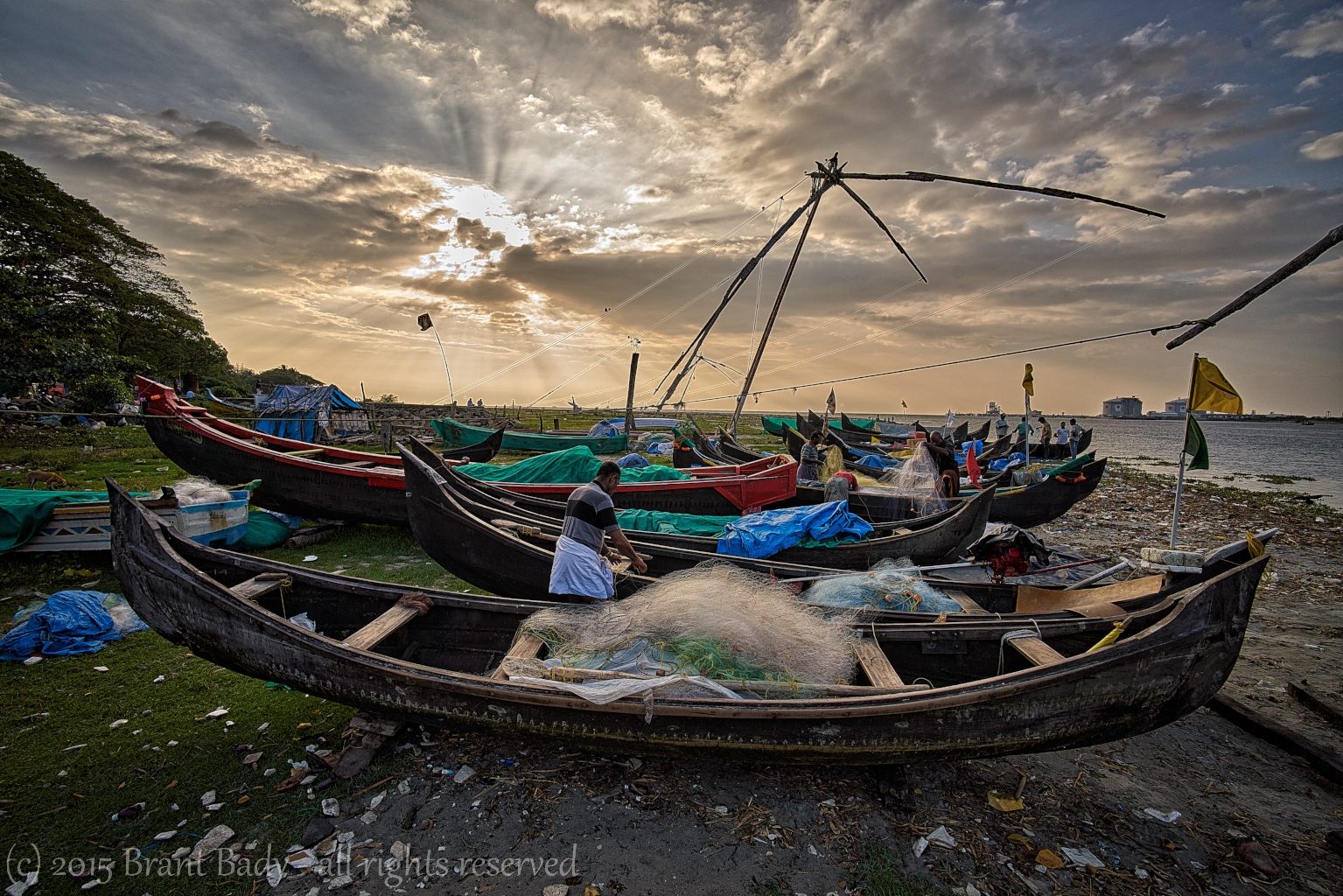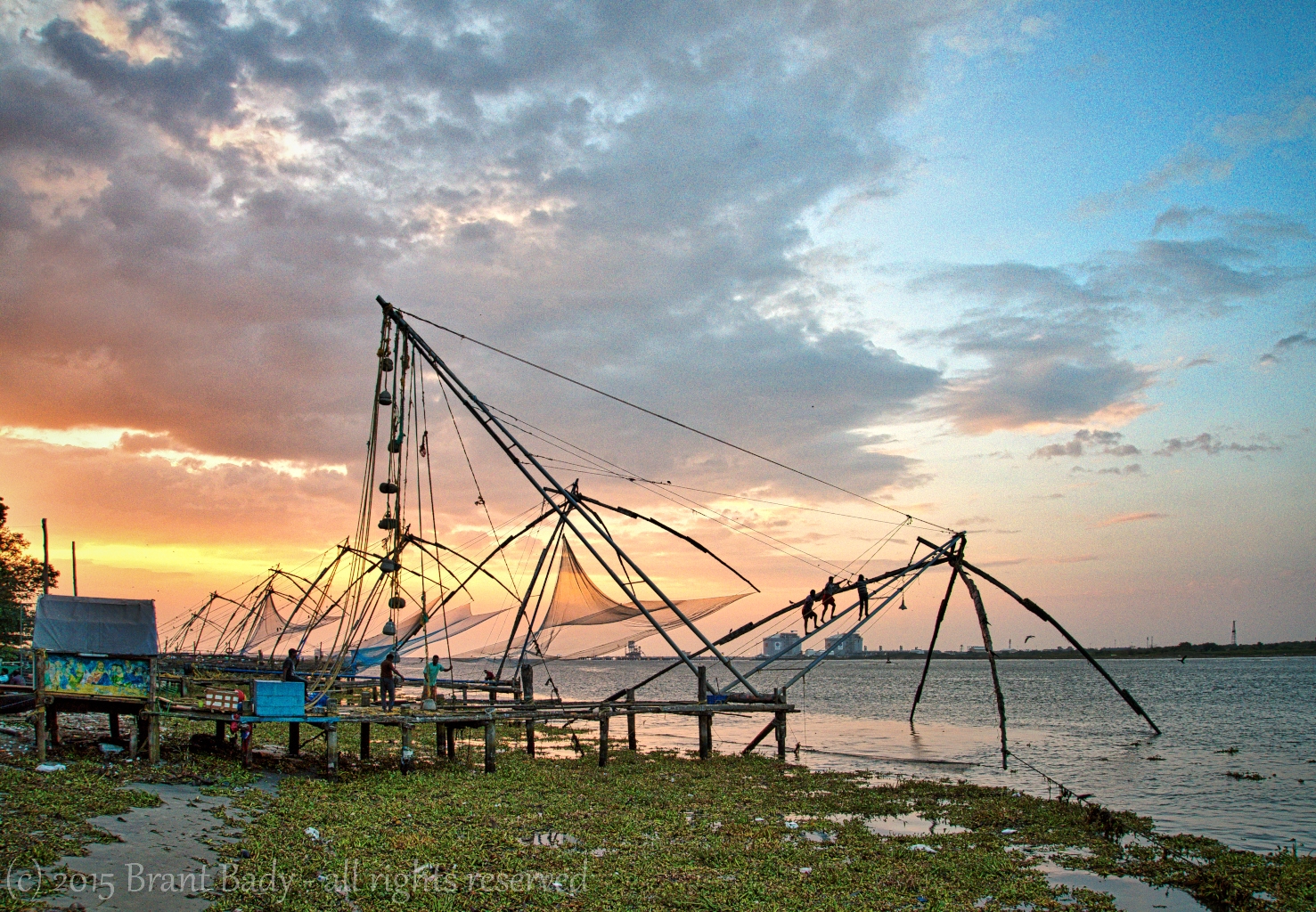After a two week side trip to Sri Lanka, that also included a few days of R&R in the Maldives (mostly scuba diving), I was back into India for more adventures, but this time I was entering in the far south, Kerala Province, which comprises 600 km of coastline on the Arabian Sea, starting with the capital, Thiruvananthapuram, and extending northward up to Mangalore.
For more than 3000 years, this area, also known as part of the Malibar Coast has been an important trading region with civilizations in the middle east. Trade may likely explain why historically Kerala has been an incredibly tolerant area in terms of different religions, faiths, and beliefs, notably Hinduism, Islam and Christianity, that have been able to both co-exist and get along together. Kerala is also notable for the “backwaters”, a series of brackish waterways inland slightly, about 900km worth, that are popular for tourist cruising as well as for movement of cargo.
Thiruvananthapuram
My first stop was Thiruvananthapuram [Trivandrum], as it was the logical connection coming from the Maldives. It isn’t a particularly intriguing city unto itself, but it did allow me to start to get a feel for how things “work” in India.
First mission, get an Indian SIM card, 2nd mission, find someplace to have a good steak!
Oops, I better explain that last reference… I am the first person to look down in disdain against those who travel to far places, but stay in western hotel chains, sit by the swimming pool all day when there is a warm ocean nearby, and only eat western food, but after being away from home for a month already, I was due some comfort food for at least one night..
Getting a SIM Card
Besides the convenience of being able to make local calls, and to have a data connection for use with maps and searching locations, another very good reason to get an Indian SIM card for your unlocked phone is the ability to book and pay for trains online using cleartrip.com, because you need to have an Indian phone number to do that. Getting an Indian phone number/SIM card, proved to be much more difficult than I could have imagined compared to other places in Asia. Locating a cell phone shop in Trivandrum was not especially easy either, I basically spent the better of an afternoon in the downtown core looking for a mobile phone outlet while attempting to see some of the local sights (a couple of temples). When I finally found a shop that could sell me a SIM card, I had to get a pile of paperwork completed first, including filling out a form, getting photocopies of my passport and visa, AND having to get a passport style photo done for the application. Eventually I got the SIM card, and it was supposedly set to activate overnight.
Finding Some Non-Veg Food
So I moved on to mission two – finding a steak! I actually wasn’t craving one at this point, but one of the guys I was scuba diving with in the Maldives had provided some tips on India, and Trivandrum (it being the closest Indian airport to the Maldives).. so the seed was planted in my brain, and he even suggested a couple of restaurants where I could find one (beef not being widely available in India – except with the Muslim populations, and Southern India being a particular haven/paradise for vegetarians). However, being the carnivore that I am, that hypnotic suggestion of a real steak tipped the decision making scales. I wound up at the Taj Hotel in Trivandrum, spent a bit of time in the lounge cooling off with some ice cold Kingfisher Beer and watching cricket on the lounge TV, then it was time for dinner service in the dining room, and my steak was waiting. The steak was nicely done and tasty, and it was indeed a welcome change, but it was probably water buffalo not beef.
Buses
The next morning I was moving on, heading up the coast to Varkala by local bus. The challenge at the bus station was to actually figure out which bus was going where, as they are certainly not marked in English, and of course I don’t speak or read Hindi. Eventually, after much asking I was on my way north mingling with the local folks. This was a situation that would frequently repeat itself on this trip.. I found the local buses very convenient, as I didn’t need a ticket in advance, and I could just arrive at the station and normally be assured of getting on a short haul local bus leaving every hour.. (however the longer the duration of the planned trip, the less likely there would be many frequent departures at convenient times during the middle of the day. Trips of under four hours usually had enough runs that one needed wait no more than an hour or two at the station).
I found Indian buses to be generally much cleaner than the trains, but badly set up for handling luggage. I was carrying two bags, one was a backpack with all my camera gear, laptop and valuables – which NEVER left my side – and the second was rolling suitcase for clothes and everything else. The overhead racks were far to small to hold either, so I would normally have the backpack on my lap or beside me in the aisle, and then try to find another spot for the suitcase (often parking it up front near the drivers compartment). Frequently the bus conductor would try to get me to move all my stuff to the very back, but of course I was loath to let anything out of my sight, and it would always be a gauntlet to get the bags back there. Only occasionally would there be a space inside the bus that was reserved for luggage or packages.
In western countries, the bus etiquette is based on the principle of first come, first served, to the extent that once seats are filled, and standing room is taken up, they don’t take on more passengers. Not so in India, where the principle is “squeeze in, there is always room for everyone”, and everyone does their best to accommodate more people.
Varkala
This town is effectively a tourist strip along the cliffs of restaurants, with many hotels and guesthouses set a bit back. There is an attractive beach at the base of the cliffs, that was surprisingly clean, with the Arabian Sea as a glorious backdrop.
More Mobile Phone Woes
What I didn’t realize was that the mobile shop back in Thiruvananthapuram only did part of the SIM card setup.. my phone was still not working so I went into town at Varkala to get it sorted out and to also cash up from an ATM. Another lesson learned, one that I surely should not have needed to be reminded of, when dealing with new setups for phone service in Asia, never leave the shop or booth until EVERYTHING is confirmed to be working. Also of note in India (which is huge. but is on just a single time zone), moving from one province to another likely means roaming charges and peridoically resetting your connection unless you specifically get an ALL-India SIM card.
Temple Festival
I am usually very immune to “touts”, effectively anyone trying to sell me a service, but I found the tourist section of Varkala, while pleasant, lacked much of the semblance of what I thought the real India was or would be like. However a scruffy looking character approached me near the taxi stand and said that there was an Elephant Festival taking place nearby that evening, and that if I wanted to see it, I should be at the parking lot at 6 pm. My first reaction was that I noted it, but wasn’t so interested as the tout looked pretty dodgy.. I even inquired to the owner of the guesthouse where I was staying, and she had no idea as to what it was about.. However nothing ventured – nothing gained, and after a bit of reflection, I decided that it could be an interesting diversion and likely to be interesting from a photographic point of view, so off I went. The tout was lurking, and it turned out he was a taxi driver.. as we walked to his car he literally had to fight off his competitors from grabbing me.. and they weren’t shy at all to cast aspersions on his character telling me he was a “bad man”. Before setting out, I clarified the destination, the time, and the round trip cost. After a relatively short drive, and we were in a nearby village and the locals were in full preparation for the ceremony, which was in fact a village festival, but elephants participating in the ceremonies were one of the highlights.
The first part of the ceremony consisted of a lone male “dancer”, in the middle of the street, he carried a club in one hand and would swat at a “pinata” like object that was held aloft by a rope, and manipulated by a couple of guys on the side to swing back and forth and go up and down to make it more challenging for the dancer, who was also subjected to having buckets of water thrown at him.
A number of elephants were stationed along the side of the road, and the next step was their involvement, each elephant was brought in front of an alter, and made to bow down, before proceeding down the street in a parade like sequence.
“Majesty in Chains”
I am certainly of two minds about this, as I do NOT support the use of elephants for any kind of entertainment purposes, and these elephants were in chains in order to control them.. However the ceremony was also clearly religious in nature, so I will withhold my judgement on the matter as I clearly have a limited understanding of the specific circumstances. What I will say is that the process required to make an elephant “relatively” safe to be near people is a horrible and abusive process, that basically means breaking down the elephants will and natural behaviors. Elephant hooks should be totally banned, and elephants are majestic and intelligent animals that only belong in the wild, not to be ridden or domesticated.
But to be fair, in Kerala province where this photo was taken, they are also well known for taking sometimes very lavish care of their elephants, and some elephants even get an annual Spa treatment as per this posting, or follow this link to the youtube video.
But before we get stupidly sentimental, we still need to remember that even after consider, or perhaps explicitly “because” of mis-treatment, elephants can be very dangerous, particularly if they are in “musth”. To give you a little bit of an idea as to just how dangerous a rogue elephant can be, here is a MUST WATCH youtube video, of a “domesticated” elephant on the rampage in Kerala province in 2016 (opens in new tab). Besides destroying motorcycles and lifting auto-rickshaw with just his trunk before he smashes it to pieces, he almost does the exact same thing with a small truck! Ahh, so suddenly I now understand the concept of having “war elephants” as a destructive force to unleash against an enemy.. and why virtually every ancient fortress in India has spikes on the outer doors as defense against war elephants!
Kollam
“Hiding from the Rain” – Kollam
I found Kollam to be the first place so far in India where I got to enjoy some really delicious regional specialty curries – so exquisite and varied. Like most Asian cuisines, Indian food doesn’t seem to travel too easily without being significantly modified (one source purports that the dismal state of Indian food around the world is the result of Bangaledeshi cooks migrating and doing their version of Indian.. — in the case where I live, it gets North Americanized. Ironically, Chinese food is quite popular in India, but it is heavily Indian-ized in taste and bears little relation to other Chinese food in Asia.
The waterway route between Kollam and Alleppey is quite popular for tourists, including Indian tourists from elsewhere in the country, to take an overnight cruise on one of the many houseboats that ply the waters, They are not particularly cost effective for a solo traveler, and the government boat does a very reasonably priced day trip along the same route, seeing the same kind of sights, such as these below:
The Charm of this route is your ability to see a variety of people living and working along the canals, river, and lakes.
“The Race Home After School”, Kerala Canals
There is also a worthwhile tour, sponsored and managed by the state tourism agency that will take you further into the backwaters, and provides enough time to look around, as opposed to just cruising by, and a narrative by a local guide.
Jungle Shack Tranquility – Backwaters Near Kollam
Kochin
Kochin is a particularly interesting town as it still has remnants from its past, such as a Jewish section (now mostly occupied by Muslims), Porterhouse architecture including the fort, and a number of places where fishers still work, either by their boats, or by using the huge Chinese fishing nets perched on the beach. The latter, still has a couple of operational nets, but the fishers are hard pressed to continue to make a viable living this way because they are fixed in location, and plagued by a lot of floating aquatic vegetation that gets caught on the net superstructure and pilings. I learned in more detail about their situation while chatting with them a couple of times as I walked around taking photographs, while explaining to them that in my youth, I too had worked in the fishing industry (in my case as an abalone, octopus, geoduck clam, sea urchin diver). Look for my post, “The hardest work I have ever done”.
“Mending The Nets”, Mahatma Gandhi Beach, Kochin
Mahatma Gandhi Beach, Kochi, India
“Last Set of The Day”, Chinese Fishing Nets, Kochin,
Of note in the above photo is that the fishermen have climbed way out onto the superstructure of the net in order to use their weight to sink it.. as it goes down into the water they move back incrementally – human counterbalances indeed!


